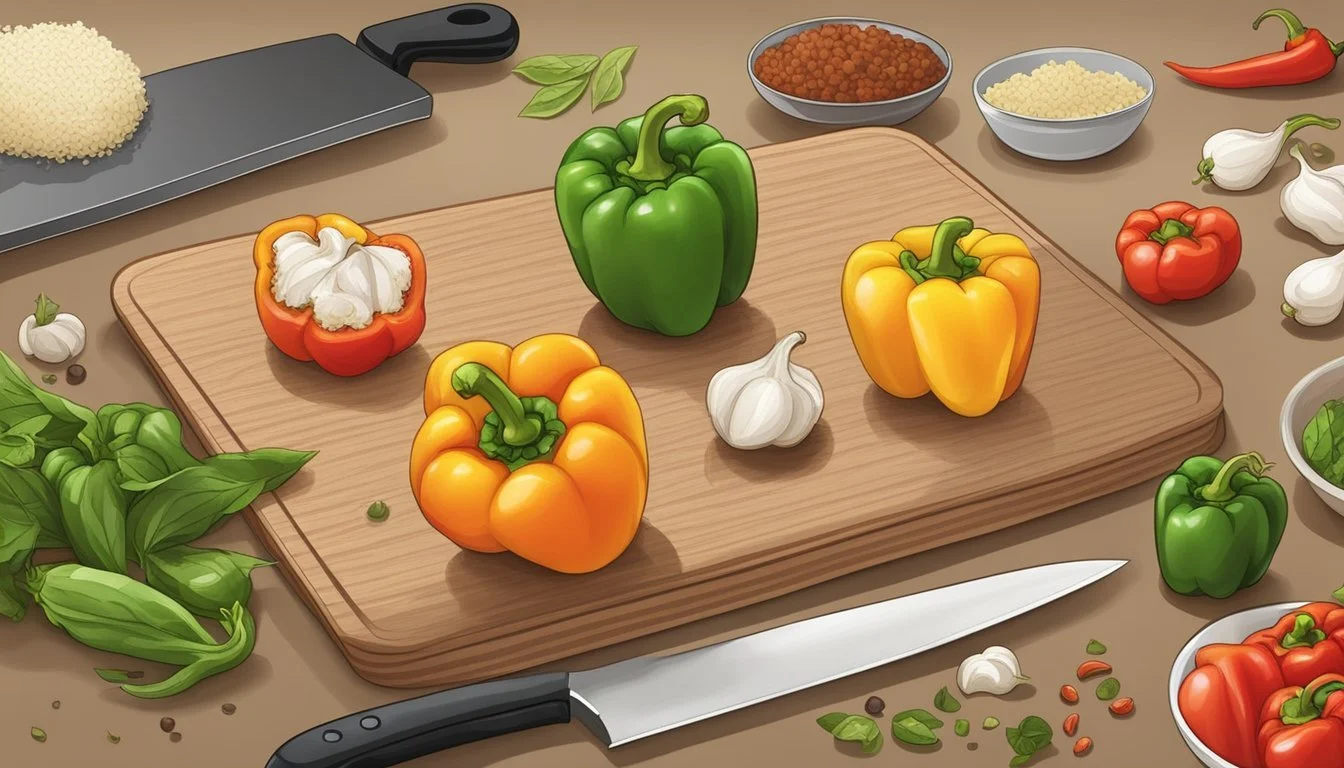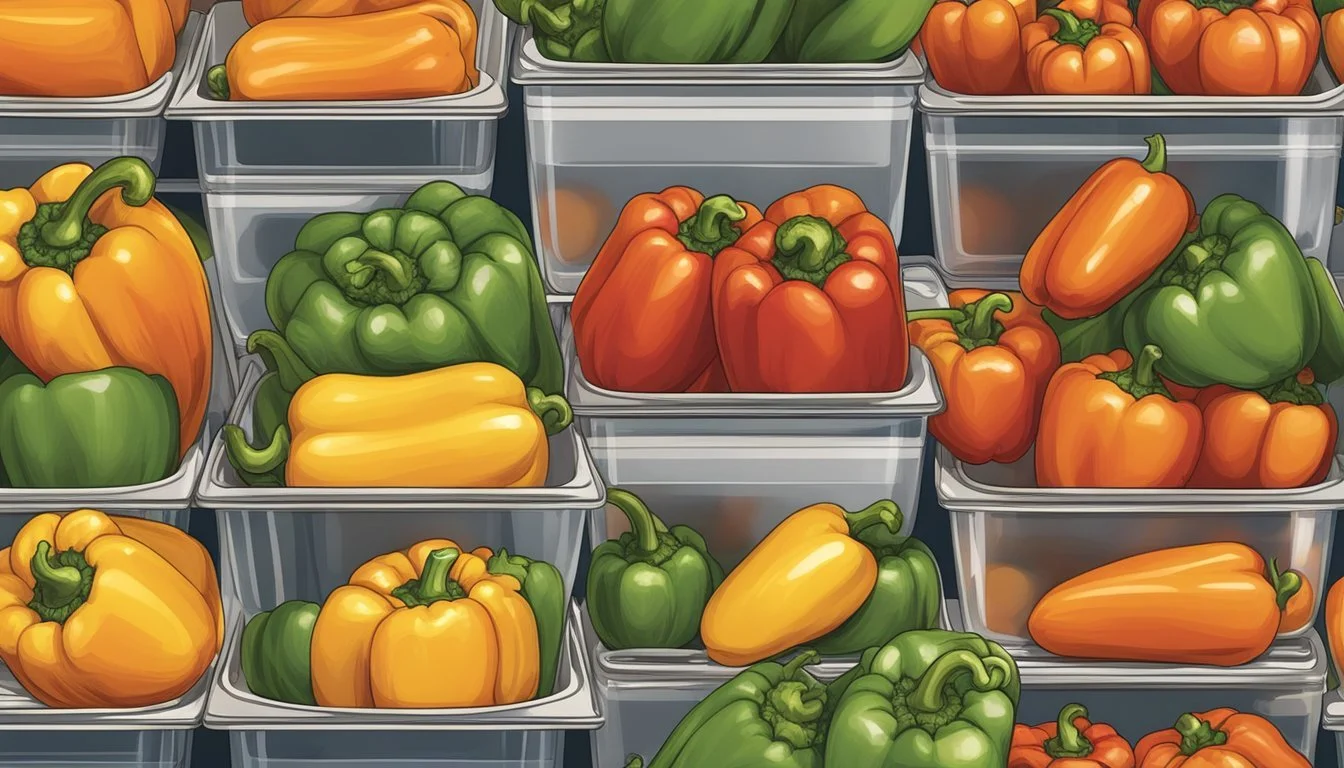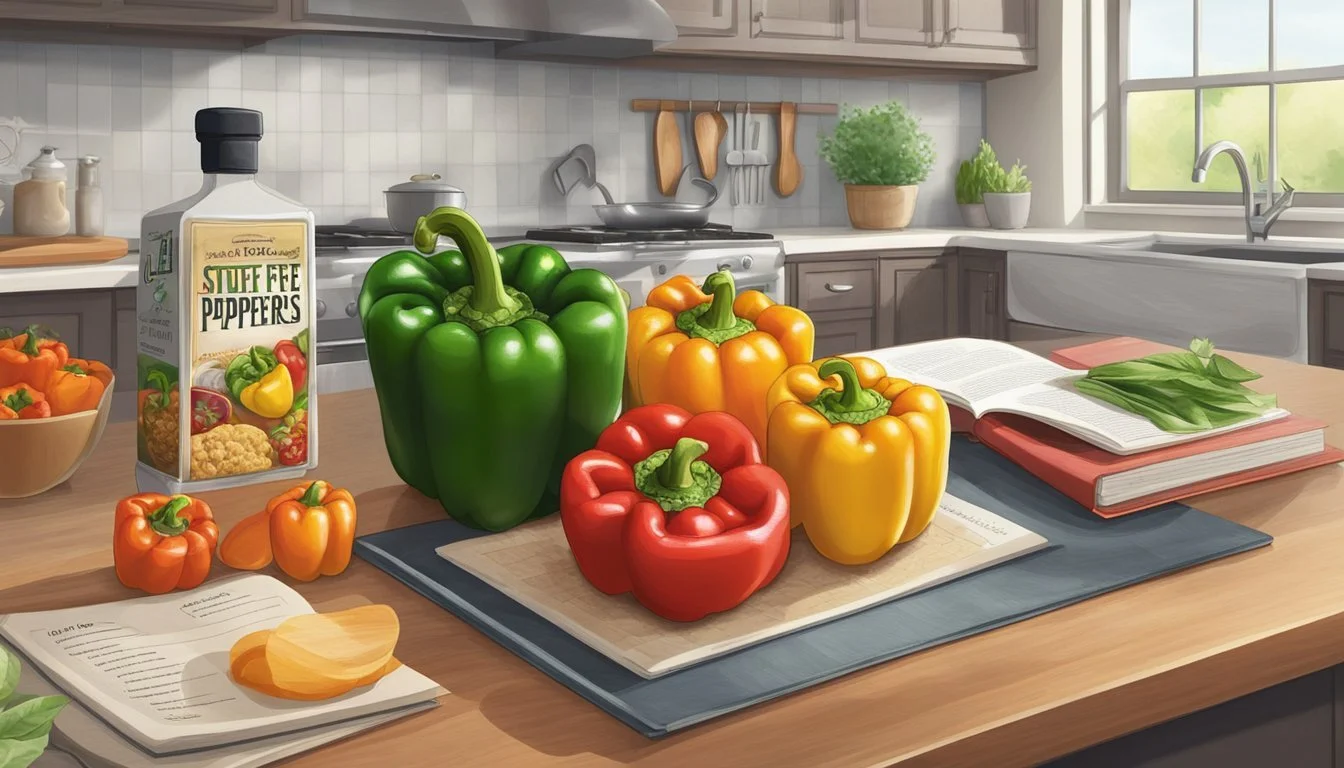How Long Do Gluten-Free Stuffed Bell Peppers Last?
Storage Tips and Shelf Life
For those following a gluten-free diet, enjoying delicious and safe-to-eat meals is a top priority. Gluten-free stuffed bell peppers are a popular choice, combining vibrant bell peppers with savory fillings such as ground beef, vegetables, and aromatic spices. They're not just delightful but also relatively easy to prepare.
When it comes to storing these tasty dishes, the key question often arises: Gluten-free stuffed bell peppers can last in the refrigerator for up to 3 to 5 days when stored properly in an airtight container. Ensuring they're adequately sealed helps maintain their taste and texture, while refrigeration slows down the growth of any potential bacteria.
For longer storage, freezing is an excellent option. Well-wrapped in plastic or stored in airtight freezer containers, gluten-free stuffed bell peppers can be frozen for up to three months. Thawing and reheating them ensures a quick and convenient meal without compromising on flavor.
Understanding Gluten-Free Stuffed Bell Peppers
Gluten-free stuffed bell peppers are a versatile and nutritious meal, accommodating a variety of dietary preferences and highlighting essential ingredients and techniques to maximize flavor and texture.
Key Ingredients for Gluten-Free Stuffed Peppers
Key ingredients such as bell peppers, ground beef, rice, and cheese are fundamental to many gluten-free stuffed pepper recipes.
Bell peppers act as the primary vessel, offering a vibrant base rich in vitamins and antioxidants.
Ground beef provides protein and a hearty flavor.
Seasonings like garlic, onion, salt, and pepper enhance the dish's depth.
Rice gives substance, soaking up flavors from other ingredients.
Cheese, typically cheddar or mozzarella, adds a creamy and delightful finishing touch.
Tomato sauce is often incorporated to bind the stuffing ingredients, ensuring they adhere well and remain flavorful.
Alternative Ingredients and Variations
Alternative ingredients cater to various dietary needs and preferences.
For a lighter option, swap ground beef with ground turkey or ground chicken.
Quinoa can replace rice for added protein and a slightly different texture.
To make it dairy-free, use dairy-free cheese or omit cheese altogether.
Vegetables such as mushrooms, zucchini, and carrots can be added to the stuffing to increase fiber and nutrients. This not only improves the healthiness of the dish but also adds varying textures and flavors. For those wanting to experiment, different colors of bell peppers can subtly alter the taste and nutrient profile.
Gluten-Free Cooking Techniques
Effective cooking techniques ensure that gluten-free stuffed peppers remain tasty and nutritious.
Start by blanching the bell peppers in boiling water for 3-4 minutes to soften them.
In a skillet, brown the ground beef and sauté onions and garlic until soft.
Combine other stuffing ingredients like rice, quinoa, or vegetables and season them well.
Baking the stuffed peppers in the oven is standard, often at around 375°F for 25-30 minutes. Cover the dish with foil initially to prevent drying, then remove it to allow the cheese to melt and turn golden. Proper prep and cook times are crucial to ensure flavors meld together and the peppers reach the right consistency.
Step-by-step Preparation
The key to making gluten-free stuffed bell peppers lies in proper preparation of the peppers, a flavorful gluten-free filling, and careful assembly before baking for the best results. Follow these steps for a successful dish.
Preparing the Peppers
Start by selecting firm, green bell peppers. Wash them thoroughly under cold water. Place the peppers on a cutting board and use a sharp knife to cut the tops off and remove the seeds and membranes inside.
Blanch the peppers in boiling water for about 3 minutes to soften them slightly. Using tongs, transfer the peppers to a bowl of ice water to stop the cooking process, then drain on paper towels. This step ensures that the peppers become tender while maintaining their shape.
Arrange the blanched peppers upright in a baking dish coated with cooking spray. Ensure there is enough space between each pepper to allow for even cooking.
Making the Gluten-Free Filling
In a large skillet, heat olive oil over medium heat. Add finely diced onions and minced garlic, sautéing until the onions are translucent and garlic is fragrant.
Add ground beef to the skillet, seasoning with salt, pepper, and a blend of your favorite herbs and spices. Cook thoroughly until the meat is browned. Stir in cooked rice, chopped tomatoes, and a small amount of tomato paste for added flavor and moisture.
Mix everything well and taste to adjust seasoning. A mixing bowl can be helpful in ensuring all the filling ingredients are thoroughly combined.
Assembling and Baking the Stuffed Peppers
Spoon the prepared filling into each blanched bell pepper, packing it tightly but not overflowing. Top each pepper with grated cheese for a crispy, golden finish. Cover the baking dish with aluminum foil.
Preheat the oven to 350°F (175°C). Bake the stuffed peppers for about 35-45 minutes. For a crispy top, remove the foil during the last 10 minutes of baking.
Once done, allow the peppers to cool for a few minutes before serving. This allows the flavors to meld and makes them easier to handle.
Proper Storage and Shelf Life
Proper storage of gluten-free stuffed bell peppers ensures they remain fresh, flavorful, and safe to eat. Adjusting storage practices can significantly impact their shelf life.
Refrigeration Guidelines
To extend the freshness of gluten-free stuffed bell peppers, store them in an airtight container. This prevents exposure to air, which can cause spoilage. Placing the container in the refrigerator helps maintain a cool environment, which is crucial for freshness.
These bell peppers typically last 3-5 days in the refrigerator.
For optimal results, avoid storing bell peppers at the refrigerator door. This is because the temperature fluctuates more frequently.
Make sure the refrigerator's temperature is set to 40°F (4°C) or lower. High sodium, sugar, fat, and cholesterol levels in the dish can also affect its shelf life.
Freezing and Reheating Tips
Freezing is an excellent method for extending the shelf life of gluten-free stuffed bell peppers. Before freezing, ensure the peppers cool completely. Place them in a freezer-safe, airtight container or use heavy-duty freezer bags. Label with the freezing date.
Frozen stuffed bell peppers can last up to three months.
When ready to eat, thaw the bell peppers in the refrigerator overnight. For reheating, use a microwave or an oven. If using a microwave, cover and heat on medium to avoid overheating. For the oven, preheat to 350°F (175°C) and bake until heated through.
Proper freezing and reheating ensure the bell peppers retain their flavor and nutritional value, including fiber.
Nutritional Information
Gluten-free stuffed bell peppers are packed with various nutrients, offering both low caloric content and numerous vitamins and minerals. These peppers also avoid common allergens and gluten, making them a suitable option for a wide audience.
Caloric Content and Macronutrients
Each serving of gluten-free stuffed bell peppers typically contains around 150-200 calories. This makes them a low-calorie meal option. They are also a great source of protein, with roughly 10-15 grams per serving from the ground beef or turkey often used in the stuffing.
The carbohydrate content usually amounts to about 20-25 grams, depending on the specific ingredients and whether any grains or rice are added. Fat content varies between 5-10 grams, with minimal trans fat and moderate amounts of saturated fat.
Micronutrients and Dietary Fiber
Bell peppers themselves are nutrient-rich, providing high levels of Vitamin C, Vitamin A, and Vitamin B6. They also contain respectable amounts of potassium and folate. The peppers and other vegetables in the stuffing contribute dietary fiber, providing approximately 3-5 grams per serving.
For those monitoring sodium intake, these stuffed peppers generally contain 250-400 mg of sodium per serving, depending on added seasonings and broth. Sugar content is relatively low, mostly coming from the natural sugars in bell peppers and other vegetables used, amounting to about 5 grams per serving.
Gluten Content and Allergens
These stuffed bell peppers are specifically designed to be gluten-free, making them an ideal choice for individuals with celiac disease or gluten sensitivities. Care should be taken to ensure all ingredients, including breadcrumbs and seasonings, are certified gluten-free.
Common allergens such as dairy and nuts can be easily avoided or substituted based on personal dietary needs. As a result, this dish is versatile and can be modified to accommodate various dietary restrictions, ensuring it remains a safe, nutritious, and enjoyable meal for everyone.
Serving Suggestions and Pairings
When serving gluten-free stuffed bell peppers, it's essential to consider complementary side dishes and beverage pairings to enhance the dining experience.
Complementary Side Dishes
Gluten-free stuffed bell peppers pair well with a variety of side dishes. For a balanced meal, consider a crisp salad with mixed greens, cherry tomatoes, and a light vinaigrette.
Roasted or steamed vegetables also make a great match. Options include zucchini, asparagus, and carrots. For a heartier option, try serving mashed cauliflower or a quinoa salad. If you're seeking a classic combination, garlic bread made with gluten-free bread offers a satisfying crunch.
For those on a keto diet, a side of avocado slices or a simple cucumber salad can keep the meal low-carb and refreshing.
Wine and Beverage Pairings
Choosing the right beverage can elevate the flavors of your stuffed peppers. For wine enthusiasts, a light red wine such as Pinot Noir or a medium-bodied white like Chardonnay complements the dish well.
Non-alcoholic options include sparkling water with a slice of lemon or a refreshing iced tea. To add a festive touch, consider serving a mocktail like a virgin mojito.
For those who prefer stronger drinks, a pale ale or a light lager offers a good balance without overpowering the flavors of the peppers. The key is to choose beverages that enhance rather than overshadow the meal.
Finishing Touches and Presentation
Perfecting the final look and taste of your gluten-free stuffed bell peppers can elevate the entire dish. Consider garnishing with herbs and cheeses, and use thoughtful plating techniques to create an appealing presentation.
Garnishing Your Stuffed Peppers
Garnishing adds a visual and flavorful touch to the stuffed bell peppers. Fresh parsley and basil are excellent choices, giving a burst of color and a hint of freshness.
Sprinkle parmesan cheese on top for a savory, crispy layer. Cheddar cheese or mozzarella can be melted over the peppers for a gooey, delicious finish.
A dash of paprika or a mix of Italian seasoning and oregano can enhance the aroma and taste. Drizzling a bit of extra virgin olive oil on top adds a lovely shine and a richer flavor profile.
Plating Techniques
Presenting the stuffed bell peppers well can make them more appetizing. Use a large, white plate to make the vibrant colors of the peppers stand out. Stand the peppers upright if they have been cooked whole, or lay them cut-side up if halved.
Arrange them in a neat row or circle, leaving space between each pepper. For added visual appeal, garnish the plate with sprigs of fresh parsley or basil.
Add a sprinkle of sea salt just before serving for a polished touch. Properly situating the peppers ensures they look inviting and delicious.
Using these finishing touches and plating techniques, your gluten-free stuffed bell peppers will not only taste great but also look stunning.
Common Mistakes to Avoid
Making gluten-free stuffed bell peppers can be a rewarding experience when done correctly. Avoiding overcooking the peppers and using incorrect seasoning amounts are key factors in ensuring the dish turns out flavorful and well-textured.
Overcooking the Peppers
Overcooking can cause the bell peppers to become mushy and lose their vibrant color. The right texture is crucial for an appealing dish. Instead of boiling the peppers for too long, blanch them for 3-5 minutes to make them flexible but not overly soft.
Using the oven at too high a temperature or for too long can also be problematic. Set the oven temperature according to the recipe, usually around 350°F to 380°F.
Cheese, an ingredient often added to stuffed peppers, can become overly browned or burnt if the baking time is extended. To prevent this, keep a close eye on the dish during the final minutes of baking.
Using Incorrect Seasoning Amounts
Seasoning is essential for flavorful stuffed peppers. Underseasoning can make the dish bland. Accurately measure salt, pepper, and other herbs and spices to enhance the natural flavor of the ingredients.
Fine sea salt is recommended for its ability to dissolve easily and evenly distribute flavor. Be cautious of amounts; too much can overpower other flavors.
When adding cheese or ingredients like unsalted butter, consider the existing salt content. Adjust the seasoning to ensure a balanced taste. Customizing the seasoning allows for better control over the final flavor. Fine-tuning the amounts will ensure the stuffed peppers are delicious and well-seasoned.
Final Considerations for Meal Planning
When planning meals that include gluten-free stuffed bell peppers, it is essential to consider both the total cooking time and how to adjust servings for the number of guests.
Calculating Total Cooking Time
To accurately plan your meal, you need to calculate the total time required for preparation and cooking.
It is important to note that prep time includes washing and cutting the peppers, sautéing ingredients, and mixing the stuffing. This process generally takes about 20-30 minutes. The cook time for stuffed peppers varies depending on the oven temperature and recipe specifics, generally ranging from 30 to 40 minutes at temperatures like 350°F to 380°F.
By adding the prep time and cook time together, the total time to prepare and cook gluten-free stuffed bell peppers will be around 50-70 minutes. Keeping these timeframes in mind ensures that the main dish is ready to serve precisely when needed.
Adjusting Servings for Guests
Adjusting the number of servings to accommodate guests ensures everyone enjoys the meal.
For events or family dinners, calculate the number of stuffed bell peppers based on the expected servings. A standard serving size could be one pepper per person, depending on the recipe's filling and the meal's role as either a main dish or part of a larger spread.
If your recipe serves four peppers and you expect six guests, preparing two extra peppers would be necessary. When scaling up or down, ensure all ingredients are adjusted proportionately to maintain the balance of flavors.
Creating a meal plan that accommodates various serving sizes and accounts for the total time needed enhances the dining experience and ensures a smooth preparation process. Adjusting calculations based on guest numbers helps achieve accurate, satisfying results.









